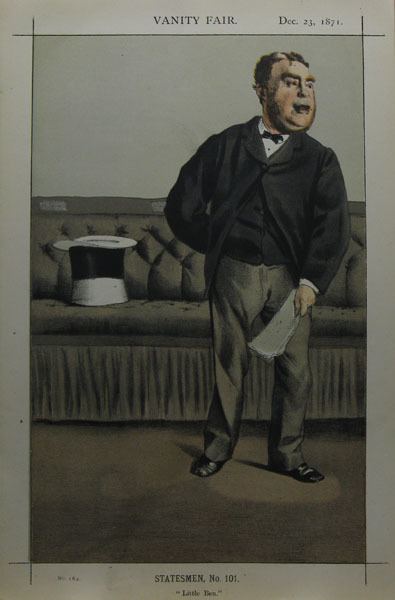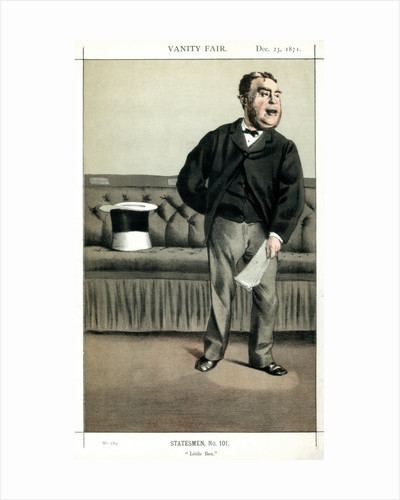Name George Cavendish-Bentinck Role Politician | Died April 9, 1891 | |
 | ||
The Right Honourable George Augustus Frederick Cavendish-Bentinck (9 July 1821 – 9 April 1891), known as George Bentinck and scored in cricket as GAFC Bentinck, was a British barrister, Conservative politician, and cricketer. A member of parliament from 1859 to 1891, he served under Benjamin Disraeli as Parliamentary Secretary to the Board of Trade from 1874 to 1875 and as Judge Advocate General from 1875 to 1880.
Contents

In cricket, he was batsman of unknown handedness, and played nine first-class games for the Marylebone Cricket Club between 1840 and 1846, as well as appearing once for the Cambridge University cricket team and again for a first-class Invitational XI match.
Early life
Cavendish-Bentinck was born in Westminster, Middlesex, in 1821, the only son of Major-General Lord Frederick Cavendish-Bentinck (1781–1828), fourth son of Prime Minister William Cavendish-Bentinck, 3rd Duke of Portland (1738–1809). His mother was Mary Lowther (d. 1863), a daughter of William Lowther, 1st Earl of Lonsdale (1757–1844), a Tory politician who served as a Member of Parliament for Appleby, Carlisle, Cumberland, and Rutland.
He was educated at Westminster School and Trinity College, Cambridge. While at Westminster School, he played for the school's First XI cricket team and faced the MCC for the first time in June 1937, scoring 14 and 13, although his team was defeated by 49 runs, and for a second time in July 1839 when he opened the innings with scores of two and six.
Career
In 1840, Cavendish-Bentinck was commissioned into the Grenadier Guards, but retired in 1841 after only a year. He joined the MCC to play against Oxford University on 11 June 1840 – his debut first-class match. Oxford, despite playing at home, fell to a heavy defeat as the MCC won by seven wickets. Cavendish-Bentinck made 11. His one appearance for Cambridge came in a match against the MCC, on 1 July 1841. Apart from various appearances for the MCC against school sides, Cavendish-Bentinck would play eight other first-class games for the MCC, scoring fifty-three runs in total, including a best of 29 not out. Add to this one match between two invitational teams – a Slow Bowlers XI featuring Bentinck versus a Fast Bowlers XI – and Cavendish-Bentinck played eleven games in total, scoring 66 runs at a low batting average of 5.50.
In 1846, he was called to the Bar from Lincoln's Inn and became an equity draftsman and conveyancer.
Political career
Cavendish-Bentinck stood unsuccessfully for the borough of Taunton at the general election April 1859, but was elected Member of Parliament (MP) for the borough at a by-election in August that year. He held the seat until the 1865 general election, when he was returned unopposed for Whitehaven. He held that seat until his death, aged 69, in 1891. He served in the second Conservative administration of Benjamin Disraeli as Parliamentary Secretary to the Board of Trade from 1874 to 1875 and as Judge Advocate General from 1875 to 1880. In 1875, he was sworn of the Privy Council.
Apart from his legal and political career, Cavendish-Bentinck was a Trustee of the British Museum from 1875 until his death and a Justice of the Peace for Cumberland and Dorset. In 1885, he was one of the staunchest adversaries of William Thomas Stead during the Eliza Armstrong case.
Personal life
On 14 August 1850, Cavendish-Bentinck married Prudentia Penelope Leslie (d. 1896), the daughter of Col. Charles Powell Leslie II. Together, they had two sons and two daughters:
Cavendish-Bentinck purchased Branksea Castle on Brownsea Island in 1873 and introduced Jersey cows and developed agriculture on the island. He died there in April 1891, aged 69. His wife survived him by five years and died in June 1896.
